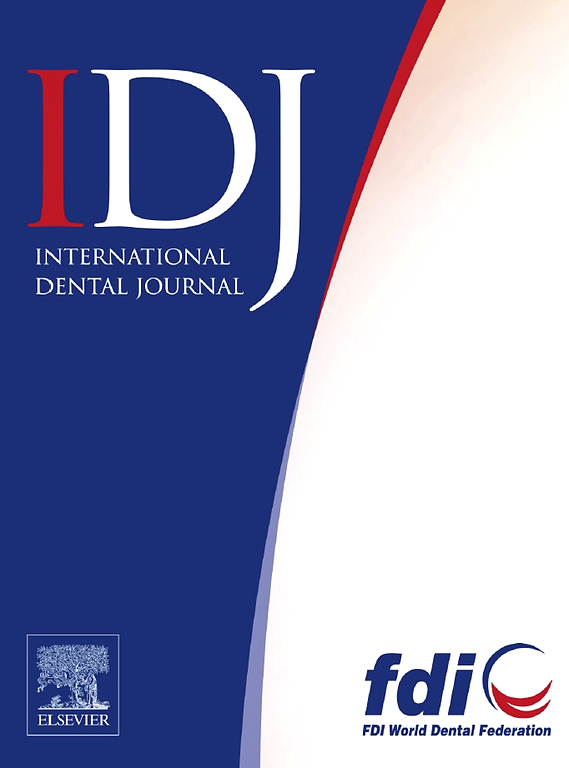Mechanical Properties and Microstructure of 3D-Printed Zirconia Based on Sintering Placement Orientation
IF 3.7
3区 医学
Q1 DENTISTRY, ORAL SURGERY & MEDICINE
引用次数: 0
Abstract
Objective
Sintering is a critical step in fabricating 3D-printed zirconia (3Dp/ZrO2) restorations and is significantly influenced by gravity. Additionally, the layer-by-layer structure of 3Dp/ZrO2 introduces anisotropy. Therefore, this study aims to investigate the influence of sintering placement orientation on the mechanical properties and microstructure of 3Dp/ZrO2.
Materials and Methods
A digital light processing-type 3D printer and ZrO2 slurry were used to fabricate green bodies, after which one-step sintering was used to create sintered 3Dp/ZrO2 products. Group-A: Sintered with the printing layer orientation parallel to the horizontal plane. Group-B: Sintered with the printing layer orientation perpendicular to horizontal plane, with the short axis aligned vertically. Group-C: Sintered with the printing layer orientation perpendicular to horizontal plane, with the long axis aligned vertically. Shrinkage ratio, bulk density, three-point and biaxial flexure tests, scanning electron microscopy with energy dispersive spectrometry, X-ray diffraction, and micro-computed tomography were used to determine the physical, mechanical, and microstructural properties of the sintered 3Dp/ZrO2 specimens.
Results
Group-B (558.28 ± 102.01 MPa) and Group-C (423.47 ± 38.46 MPa) showed a significantly lower flexure strength than Group-A (789.25 ± 57.10 MPa). More grain boundary defects and microdefects were observed in Group-B and Group-C. Different sintering placement orientations did not cause significant differences in shrinkage ratio, density, phase, or grain size.
Conclusions
The sintering placement orientation of 3Dp/ZrO2 influenced its mechanical properties and microstructure. Sintering with the printing layer orientation parallel to horizontal plane showed superior mechanical properties. In contrast, the perpendicular orientation showed compromised performance, likely due to loose grain boundaries and internal microdefects observed within 3Dp/ZrO2.
Clinical Significance
This study provides practical guidance for dental professionals by demonstrating how sintering placement orientation affects the microstructure of 3Dp/ZrO2. Considering placement orientation during sintering process can help reduce defects and improve the mechanical properties of zirconia-based restorations for better clinical outcomes.
基于烧结放置取向的3d打印氧化锆的力学性能和微观结构
目的定位是制备3d打印氧化锆(3Dp/ZrO2)修复体的关键步骤,受重力影响较大。此外,3Dp/ZrO2的分层结构引入了各向异性。因此,本研究旨在研究烧结放置方向对3Dp/ZrO2的力学性能和显微组织的影响。材料与方法采用数字光处理型3D打印机和ZrO2浆料制备绿体,一步烧结制备烧结3Dp/ZrO2产品。a组:烧结,打印层方向平行于水平面。b组:烧结,打印层方向垂直于水平面,短轴垂直对齐。c组:烧结后的印刷层方向垂直于水平面,长轴垂直对齐。采用收缩率、体积密度、三点和双轴弯曲试验、扫描电镜与能量色散光谱、x射线衍射和显微计算机断层扫描等方法测定烧结3Dp/ZrO2试样的物理、力学和显微组织性能。结果b组(558.28±102.01 MPa)和c组(423.47±38.46 MPa)的抗弯强度明显低于a组(789.25±57.10 MPa)。b组和c组晶界缺陷和微缺陷较多。不同的烧结放置方向在收缩率、密度、相或晶粒尺寸上没有显著差异。结论3Dp/ZrO2的烧结放置取向影响其力学性能和显微组织。平行于水平面的印刷层烧结表现出优异的力学性能。相反,垂直取向表现出较差的性能,可能是由于在3Dp/ZrO2中观察到松散的晶界和内部微缺陷。本研究展示了烧结放置方向对3Dp/ZrO2微结构的影响,为牙科专业人员提供了实践指导。在烧结过程中考虑放置方向有助于减少缺陷,改善氧化锆基修复体的力学性能,获得更好的临床效果。
本文章由计算机程序翻译,如有差异,请以英文原文为准。
求助全文
约1分钟内获得全文
求助全文
来源期刊

International dental journal
医学-牙科与口腔外科
CiteScore
4.80
自引率
6.10%
发文量
159
审稿时长
63 days
期刊介绍:
The International Dental Journal features peer-reviewed, scientific articles relevant to international oral health issues, as well as practical, informative articles aimed at clinicians.
 求助内容:
求助内容: 应助结果提醒方式:
应助结果提醒方式:


